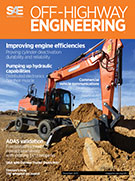Magazine

SAE Truck & Off-Highway Engineering: February 2017
2017-02-02
The next phase Meeting Phase 2 fuel efficiency and GHG emissions for heavy trucks will require multiple technology pathways-some of which are still on the horizon. Active vibration damping for construction machines An innovative concept for an active system to reduce machine oscillations based on frequency identification. Consumer electronics come on board Smartphones and tablets are likely to play a large role in HMIs for heavy vehicles-if productivity and safety are not compromised. Patton's new campaign As new SAE International President for 2017, Doug Patton will advocate STEM, "cultivation" of prospective young engineers. PACCAR's Sproull primed for SAE Commercial Vehicle post As SAE International's new 2017-2020 Commercial Vehicle Sector VP, Landon Sproull intends to bolster the society's involvement in evolving industry regulations and to better cultivate cross-sector alliances.








